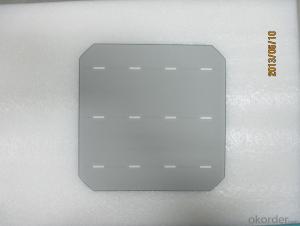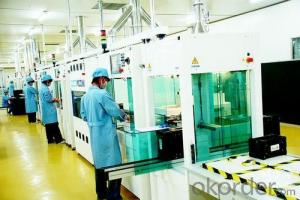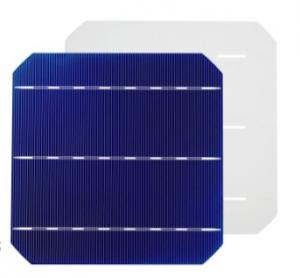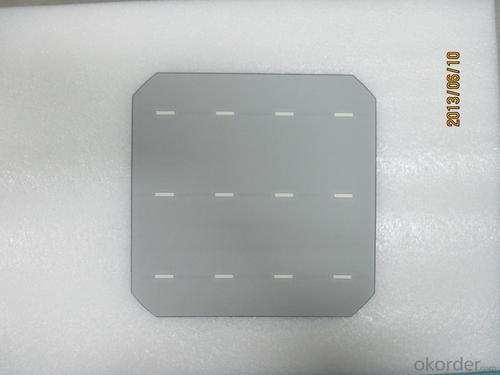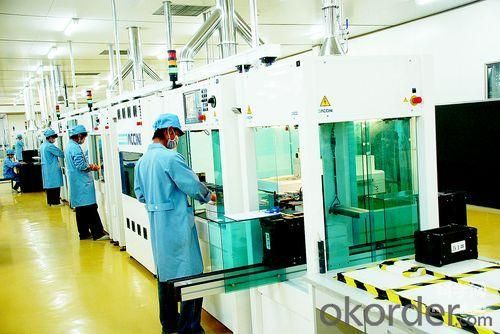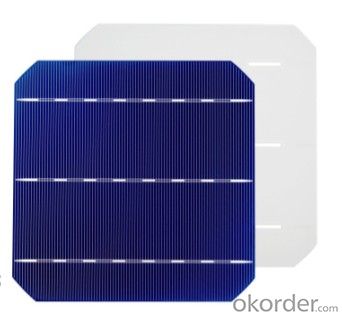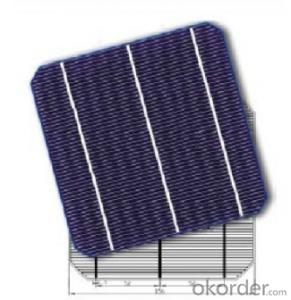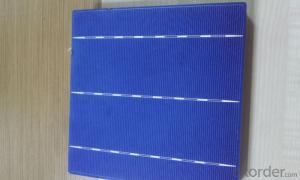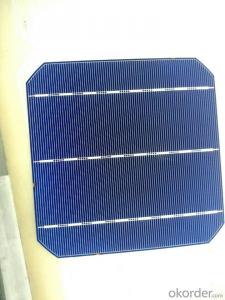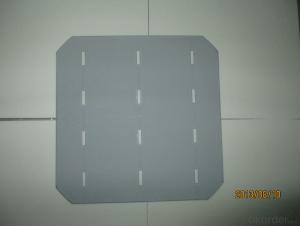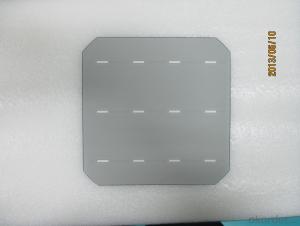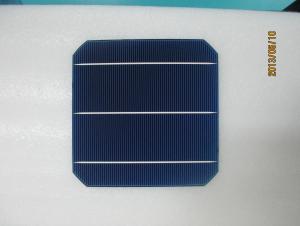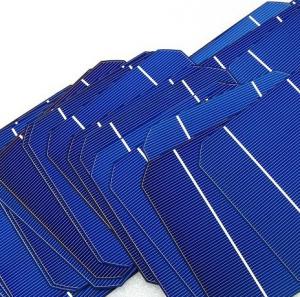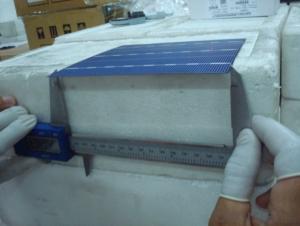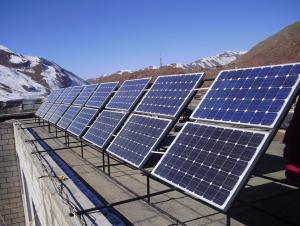Buy Small Solar Cells:156*156mm Monocrystal Solar Cell with 4.42 Watt High Efficiency
- Loading Port:
- Shanghai
- Payment Terms:
- TT or LC
- Min Order Qty:
- 1000 pc
- Supply Capability:
- 20000000 pc/month
OKorder Service Pledge
OKorder Financial Service
You Might Also Like
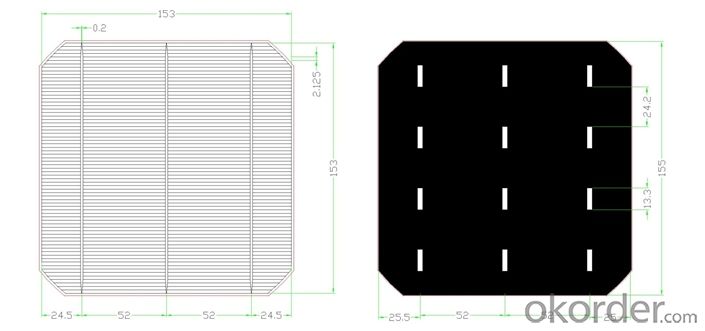
Monocrystal solar energy cell
type:156M
appearance:156×1565㎜±0.5mm;diagonal:R=100mm
Main fence wide:1.4-1.5mm back electrode wide:2-2.5mm
Fence line qty:90
Cell thickness:220um±20um
Eff(%) | 18.50- 18.60 | 18.60- 18.70 | 18.70- 18.80 | 18.80- 18.90 | 18.9- 19.0 | 19.1- 19.1 | 19.1- 19.2 | |||||
Pm(W) | 4.42 | 4.44 | 4.47 | 4.49 | 4.52 | 4.54 | 4.56 | |||||
Isc(A) | 8.82 | 8.83 | 8.85 | 8.86 | 8.88 | 8.9 | 8.93 | |||||
Im(A) | 8.33 | 8.35 | 8.39 | 8.42 | 8.45 | 8.47 | 8.51 | |||||
Voc(V) | 0.634 | 0.635 | 0.636 | 0.637 | 0.637 | 0.638 | 0.64 | |||||
Vm(V) | 0.532 | 0.534 | 0.534 | 0.535 | 0.536 | 0.537 | 0.538 | |||||
FF(%) | 79.3 | 79.5 | 79.6 | 79.8 | 80 | 80 | 80 |

remark:our company cells as per working current concentrate principle,separate the first and the second grade
Usage of Polycrystalline Solar Cells
Solar cells are often electrically connected and encapsulated as a module. Photovoltaic modules often have a sheet of glass on the front (sun up) side, allowing light to pass while protecting the semiconductor wafers from abrasion and impact due to wind-driven debris, rain, hail, etc. Solar cells are also usually connected in series in modules, creating an additive voltage. Connecting cells in parallel will yield a higher current; our solar cells have passed IEC Certification. With high and stable quality, our cells can greatly improve the performance of Solar Modules.
Applications of Polycrystalline Solar Cells
Assemblies of photovoltaic cells are used to make solar modules which generate electrical power from sunlight, as distinguished from a "solar module" or "solar panel". A solar array generates solar power using solar energy.
Factory Picture of Solar Cells
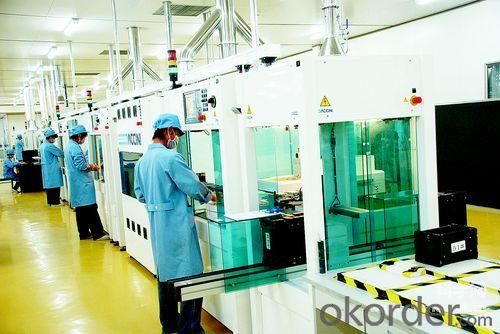
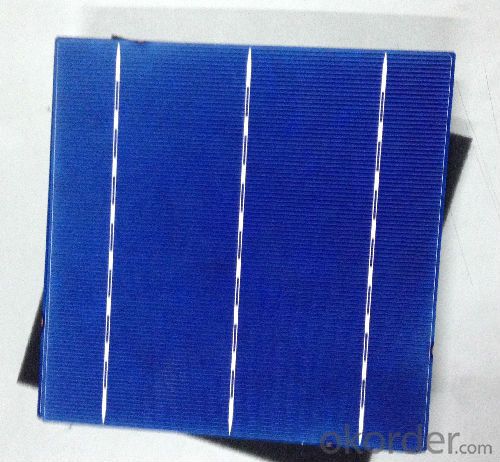
FAQ
We have organized several common questions for our clients,may help you sincerely:
What’s price per watt?
A: It’s depends on the quantity, delivery date and payment terms of the order. We can talk further about the detail price issue. Our products is high quality with lower price level.
Can you tell me the parameter of your solar cells?
We have different series of cells with different power output, both from c-si to a-si. Please take our specification sheet for your reference.
How do you pack your products?
We have rich experience on how to pack the panels to make sure the safety on shipment when it arrives at the destination.
Can you do OEM for us?
Yes, we can.
How long can we receive the product after purchase?
In the purchase of product within three working days, We will arrange the factory delivery as soon as possible. The perfect time of receiving is related to the state and position of customers. Commonly 7 to 10 working days can be served
- Q: How can the solar power change our life by using solar cells material?
- There is a lot of research indicating that by the mass use of solar cells, the solar power is becoming one of the least expensive overall sources of power
- Q: What is the payback period for installing solar cells?
- The payback period for installing solar cells varies depending on several factors such as the initial cost of the installation, the amount of energy generated, and the cost of electricity. On average, it typically takes between 5 to 10 years for solar cells to recoup their initial investment through energy savings.
- Q: How to generate solar cells, the principle of PN junction
- Solar energy is an inexhaustible renewable energy source for human beings, and it is clean energy and does not produce any environmental pollution. In the effective use of solar energy; solar energy photoelectric utilization is the fastest growing and most dynamic in recent years
- Q: Can a solar cell be used in commercial buildings?
- Yes, of course, it can .
- Q: How long does it take to make a solar cell?
- It is now mass produced, so it doesn't take long to make it in the factory.
- Q: What is the role of anti-reflective coatings on solar cells?
- The role of anti-reflective coatings on solar cells is to minimize the reflection of sunlight off the surface of the cells, allowing more light to be absorbed and converted into electricity. This improves the overall efficiency and performance of the solar cells.
- Q: Can solar cells be used in residential applications?
- Yes, solar cells can be used in residential applications. In fact, they are increasingly being utilized in homes as a renewable and sustainable source of energy. Solar panels can be installed on rooftops or in yards to convert sunlight into electricity, reducing dependency on traditional power grids and lowering energy costs for homeowners.
- Q: How do solar cells perform in areas with high levels of air humidity?
- Solar cells generally perform slightly less efficiently in areas with high levels of air humidity. This is because the water molecules in the air can scatter and absorb some of the incoming sunlight, reducing the amount of light that reaches the solar cells. However, the impact of humidity on solar cell performance is generally minimal and can be compensated by using anti-reflective coatings or cleaning the panels regularly.
- Q: Can solar cells be used for desalination purposes?
- Yes, solar cells can be used for desalination purposes. Solar-powered desalination systems, such as solar stills and solar desalination plants, harness the energy from the sun to power the desalination process. This renewable energy source helps reduce the environmental impact of desalination and promotes sustainable water production.
- Q: Can solar cells be used for powering traffic lights?
- Yes, solar cells can be used for powering traffic lights. Solar panels can generate electricity from sunlight, which can then be stored in batteries and used to power traffic lights without the need for a traditional electrical grid connection. This is an environmentally-friendly and cost-effective solution for powering traffic lights in areas where it may be challenging to provide a constant power supply.
Send your message to us
Buy Small Solar Cells:156*156mm Monocrystal Solar Cell with 4.42 Watt High Efficiency
- Loading Port:
- Shanghai
- Payment Terms:
- TT or LC
- Min Order Qty:
- 1000 pc
- Supply Capability:
- 20000000 pc/month
OKorder Service Pledge
OKorder Financial Service
Similar products
Hot products
Hot Searches
Related keywords
